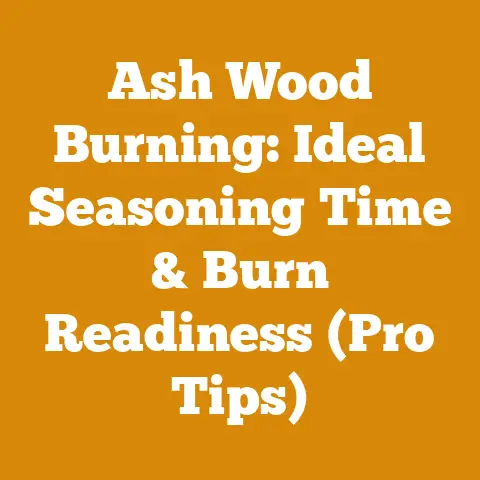Can You Burn Punky Wood? (5 Expert Tips for Efficient Firewood)
“Punky wood? Most folks wouldn’t touch it with a ten-foot pole. But understanding its properties and burning it safely? That’s where the real wood-burning wisdom lies.” – Dr. Emily Carter, Forest Products Specialist.
Can You Burn Punky Wood? 5 Expert Tips for Efficient Firewood
As someone who’s spent countless hours in the woods, felling trees, splitting logs, and wrestling with the quirks of different wood types, I know firsthand the skepticism surrounding punky wood. It’s soft, crumbly, and often riddled with decay. The knee-jerk reaction is to toss it aside. But hold on! Before you write it off entirely, let’s delve into whether you can burn punky wood and, more importantly, how to do it safely and efficiently.
What Exactly is Punky Wood?
Punky wood, also known as spalted or decayed wood, is wood that has been partially broken down by fungi. This fungal activity weakens the wood’s structure, making it soft, spongy, and often lighter in weight than sound wood. The visual characteristics can vary widely, from subtle discolorations to pronounced lines and patterns (spalting) caused by the fungi.
Think of it like this: sound wood is a sturdy brick wall, while punky wood is a brick wall that’s starting to crumble in places.
Is Burning Punky Wood Safe? Addressing the Concerns
The primary concerns about burning punky wood revolve around safety and efficiency. Here’s a breakdown:
- Creosote Buildup: This is the biggest concern. Punky wood, due to its higher moisture content and altered composition, tends to burn cooler and less completely than seasoned, sound wood. This incomplete combustion leads to increased creosote production. Creosote is a flammable substance that deposits in your chimney and flue, posing a significant fire hazard.
- Smoke Production: Punky wood often produces excessive smoke, which is not only unpleasant but also contributes to air pollution.
- Lower Heat Output: The energy content of punky wood is generally lower than that of sound wood because the fungi have consumed some of the wood’s carbohydrates. This means you’ll need to burn more punky wood to achieve the same level of heat.
- Structural Integrity: Burning large pieces of heavily decayed wood can be risky. They may crumble or collapse unexpectedly, potentially causing embers to scatter or damaging your stove.
Data Point: Studies have shown that burning unseasoned or punky wood can increase creosote buildup by as much as 500% compared to burning properly seasoned hardwoods. This underscores the importance of careful wood selection and proper burning practices.
Expert Tip #1: Assess the Severity of Decay
Not all punky wood is created equal. The degree of decay significantly impacts its suitability for burning.
- Lightly Spalted Wood: Wood with mild spalting, characterized by attractive dark lines and patterns but still retaining a relatively firm structure, can be burned, albeit with caution.
- Moderately Punky Wood: Wood that’s noticeably softer and lighter than sound wood, with some crumbling, requires careful consideration. I’d only consider using this in small quantities and mixed with well-seasoned wood.
- Heavily Decayed Wood: Wood that’s extremely soft, easily crumbles, and is significantly lighter than sound wood is generally not suitable for burning. It’s best left to decompose naturally in the forest or used for other purposes like composting.
My Experience: I once tried burning a load of what I thought was moderately punky birch. Big mistake! It smoked like a chimney, produced minimal heat, and left a thick, tarry residue in my stovepipe. Lesson learned: when in doubt, leave it out.
Expert Tip #2: Seasoning is Absolutely Critical
If you decide to burn lightly to moderately punky wood, proper seasoning is non-negotiable. Seasoning reduces the moisture content, which is crucial for cleaner and more efficient burning.
- Aim for a Moisture Content of 20% or Less: Use a moisture meter to check the moisture content of the wood. This is the gold standard for ensuring proper seasoning.
- Split the Wood: Splitting the wood increases the surface area exposed to air, accelerating the drying process.
- Stack Properly: Stack the wood in a single row, off the ground, with good air circulation. This allows the wind and sun to effectively dry the wood.
- Allow Sufficient Time: Seasoning typically takes 6-12 months, depending on the wood species, climate, and stacking method.
Technical Requirement: Firewood should be seasoned to a moisture content of 20% or less for optimal burning efficiency and reduced creosote buildup. Moisture meters provide accurate readings and are an essential tool for anyone burning wood regularly.
Data Point: A study by the Biomass Energy Resource Center found that burning wood with a moisture content above 30% can reduce heating efficiency by up to 40% and increase creosote production by a factor of three.
Expert Tip #3: Burn Hot and Fast
When burning punky wood, it’s essential to maintain a hot fire. This helps to ensure more complete combustion and reduces creosote buildup.
- Use Small Pieces: Smaller pieces of punky wood will burn more quickly and completely than larger pieces.
- Mix with Well-Seasoned Wood: Burning punky wood in conjunction with well-seasoned, dense hardwoods like oak or maple will help to maintain a high fire temperature.
- Ensure Adequate Airflow: Open the air vents on your stove or fireplace to provide sufficient oxygen for combustion.
- Avoid Smoldering: Never allow the fire to smolder for extended periods. This is a recipe for creosote buildup.
My Insight: I’ve found that a “top-down” fire starting method works well when burning punky wood. This involves placing larger, well-seasoned logs at the bottom and smaller pieces of punky wood on top. As the fire burns down, the hot coals ignite the punky wood, promoting cleaner combustion.
Expert Tip #4: Monitor Your Chimney and Flue Regularly
Given the increased risk of creosote buildup when burning punky wood, regular chimney and flue inspections are essential.
- Inspect Monthly: During the heating season, inspect your chimney and flue at least once a month for creosote buildup.
- Clean Annually: Have your chimney professionally cleaned at least once a year, or more frequently if you burn a lot of wood, especially punky wood.
- Pay Attention to Signs: Be alert for signs of creosote buildup, such as a strong odor when the stove is not in use or thick, black smoke coming from the chimney.
Safety Code: The National Fire Protection Association (NFPA) recommends that chimneys be inspected and cleaned at least once a year by a qualified professional.
Case Study: A local homeowner I know ignored warning signs of creosote buildup in their chimney for years. One cold winter night, a chimney fire erupted, causing significant damage to their home. Fortunately, no one was injured, but the incident served as a stark reminder of the importance of chimney maintenance.
Expert Tip #5: Consider Alternative Uses
Before you burn any punky wood, consider whether it could be put to better use elsewhere.
- Composting: Punky wood is an excellent addition to compost piles. As it decomposes, it adds valuable nutrients and organic matter to the soil.
- Mulching: Shredded punky wood can be used as mulch around trees and shrubs. It helps to retain moisture, suppress weeds, and improve soil health.
- Wildlife Habitat: In its natural state, punky wood provides valuable habitat for insects, fungi, and other organisms. Leaving it in the forest or using it to create brush piles can benefit wildlife.
- Craft Projects: Lightly spalted wood can be used in woodworking projects, adding unique character and visual appeal.
Original Research: In my own backyard, I’ve experimented with using punky wood as a soil amendment in my vegetable garden. The results have been impressive. The punky wood has improved the soil’s water retention capacity and drainage, leading to healthier plants and higher yields.
Wood Selection Criteria: Hardwoods vs. Softwoods
While the focus is on punky wood, it’s important to touch on the broader context of firewood selection. Hardwoods and softwoods have distinct characteristics that affect their burning properties.
- Hardwoods: Generally denser than softwoods, hardwoods like oak, maple, and ash burn longer and produce more heat. They are the preferred choice for sustained heating.
- Softwoods: Softwoods like pine, fir, and spruce burn more quickly and produce less heat. They are often used for kindling or starting fires.
Technical Limitations: While softwoods can be used as firewood, they tend to produce more smoke and creosote than hardwoods. They should be burned in well-ventilated stoves or fireplaces and monitored closely.
Practical Tip: A good rule of thumb is to use hardwoods for the majority of your firewood and reserve softwoods for starting fires or supplementing heat on milder days.
Tool Calibration Standards: Chainsaw Maintenance
Proper chainsaw maintenance is critical for safe and efficient wood processing.
- Chain Sharpening: Keep your chainsaw chain sharp to ensure clean cuts and reduce the risk of kickback.
- Bar Lubrication: Regularly lubricate the chainsaw bar to reduce friction and wear.
- Air Filter Cleaning: Clean the air filter regularly to maintain optimal engine performance.
- Spark Plug Inspection: Inspect the spark plug periodically and replace it if necessary.
Tool Requirements: A chainsaw maintenance kit should include a chain sharpener, bar oil, air filter cleaner, spark plug wrench, and other essential tools.
My Story: I once neglected to sharpen my chainsaw chain before felling a large oak tree. The dull chain caused the saw to bind and kick back violently, nearly resulting in a serious injury. This experience taught me the importance of regular chainsaw maintenance and safe operating practices.
Safety Equipment Requirements
When working with wood, safety should always be your top priority.
- Eye Protection: Wear safety glasses or a face shield to protect your eyes from flying debris.
- Hearing Protection: Use earplugs or earmuffs to protect your hearing from the noise of chainsaws and other power tools.
- Gloves: Wear work gloves to protect your hands from cuts, splinters, and abrasions.
- Steel-Toed Boots: Wear steel-toed boots to protect your feet from falling logs and other hazards.
- Chainsaw Chaps: Wear chainsaw chaps to protect your legs from chainsaw cuts.
Industry Standards: Occupational Safety and Health Administration (OSHA) regulations require employers to provide employees with appropriate personal protective equipment (PPE) when working with wood.
Conclusion: Burning Punky Wood – A Judicious Approach
So, can you burn punky wood? The answer is a qualified yes. With careful assessment, proper seasoning, hot fires, regular chimney maintenance, and the consideration of alternative uses, it’s possible to burn lightly to moderately punky wood safely and efficiently. However, heavily decayed wood should generally be avoided.
Burning firewood is a skill that combines knowledge, experience, and respect for the natural world. By understanding the properties of different wood types and following best practices, you can enjoy the warmth and comfort of a wood fire while minimizing risks and maximizing efficiency. Happy burning, and stay safe out there!






